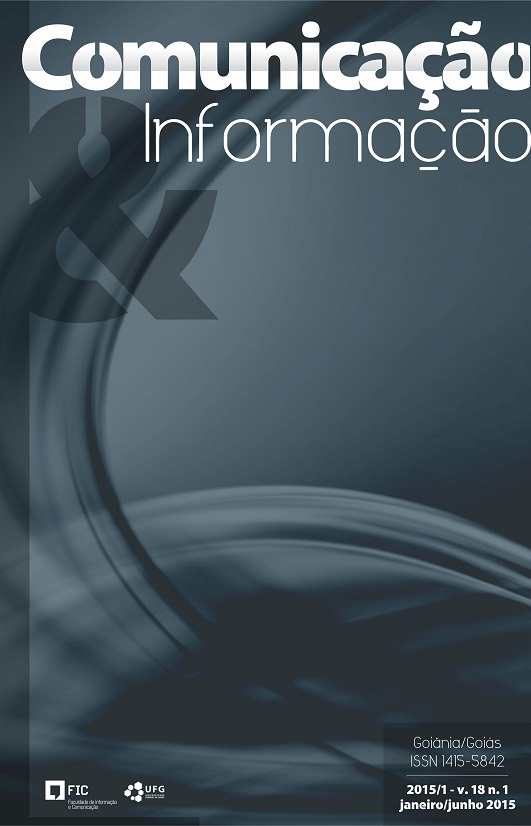Utilização de técnicas de jogos para a análise visual de informações
DOI:
https://doi.org/10.5216/32365Palavras-chave:
Técnicas de jogos. Gamification. Interação homem-maquina (HCI). Análise visual de informações. Processo decisório.Resumo
O excesso de informações e a abundância de dados, com diversidade na forma e no conteúdo, tornam os processos de tomada de decisão mais complexos. Nesse contexto, a apresentação visual das informações tem se mostrado uma alternativa interessante de apoio aos gestores e especialistas. Contudo, é necessário que as interfaces sejam adequadas para facilitar e promover a análise das informações. Nesse contexto, este artigo descreve pesquisas que utilizam o conceito de jogos. Explora-se a importância da gestão da informação, a utilização do gamification para a análise visual de informações, bem como as motivações psicológicas relacionadas às mecânicas de jogos no processo decisório. Em função da baixa quantidade de estudos sobre o emprego de gamification nessa área, o artigo traz reflexões relevantes sobre o tema.
Downloads
Referências
CODECADEMY. Aprenda a programar de maneira interativa e gratuita. [S. l.], [201-]. Disponível em: <http://www.codecademy.com>. Acesso em: 31 Ago. 2014.
DAVENPORT, T. H.; PRUSAK, L. Information ecology: mastering the information and knowledge environment. USA: Oxford University Press, 1997.
DETERDING, S. et al. From game design elements to gamefulness: defining “gamification”. In: INTERNATIONAL ACADEMIC MINDTREK CONFERENCE: ENVISIONING FUTURE MEDIA ENVIRONMENTS. 15., 2011, Tampere, Finland. Proceedings… New York: ACM, 2011. p. 9-15.
DETERDING, S. Gamification: designing for motivation. Interactions, v. 19, n. 4, p. 14 - 17, 2012.
EBERT, A.; GERSHON, N. D.; VEER, G. V. der. Human-computer interaction: introduction and overview. Künstliche Intelligenz, v. 26, n. 2, p. 121 – 126, 2012.
FERRO, L. S.; WALZ, S. P.; GREUTER, S. Towards personalised, gamified systems: an investigation into game design, personality and player typologies. In: AUSTRALASIAN CONFERENCE ON INTERACTIVE ENTERTAINMENT: MATTERS OF LIFE AND DEATH. 9., 2013, Melbourne, Australia. Proceedings… New York: ACM, 2013. p. 1-6.
GARTNER. Gartner says by 2015, more than 50 percent of organizations that manage innovation processes will gamify those processes. Newsroom, Egham, UK, april 2011. Disponível em: . Acesso em: 19 out. 2014.
GARTNER. Gartner says by 2014, 80 percent of current gamified applications will fail to meet business objectives primarily due to poor design. Newsroom, Stamford, Conn. nov. 2012. Disponível em: . Acesso em: 19 out. 2014.
GOODMAN, S. K. Information needs for managing decision-making. Records Management Quaterly, v. 27, n. 4, p. 12-23. 1993.
HAMARI, J.; KOIVISTO, J.; SARSA, H. Does gamification work? A literature review of empirical studies on gamification. In: HAWAII INTERNATIONAL CONFERENCE ON SYSTEM SCIENCES. 47., 2014, Hawaii, USA. Proceedings… Hawaii, USA, 2014. p. 3025-3034.
HÄGGLUND, P. Taking gamification to the next level: a detailed overview of the past, the present and a possible future of gamification. Student thesis (Degree of bachelor)-Umeå Universitet, Umeå, 2012.
IANDOLI, L.; KLEIN, M.; ZOLLO, G. Can we exploit collective intelligence for collaborative deliberation? The case of the climate change collaboratorium. MIT Sloan Research Paper, Massachusetts, n. 4675, jul. 2008. Disponível em: < http://ssrn.com/abstract=1084069>. Acesso em: 19 out. 2014.
KARACAPILIDIS, N.; PAPADIAS, D. Computer supported argumentation and collaborative decision making: the HERMES system. Information Systems, v. 26, n. 4, p. 259-277, 2001.
KENNERLEY, M.; MASON, S. The use of information in decision making: literature review for the Audit Commission. Centre for Business Performance, Cranfield School of Management, 2008. Disponível em: <http://archive.audit-commission.gov.uk/auditcommission/sitecollectiondocuments/AuditCommissionReports/NationalStudies/Cranfield_Information_use_review.pdf>. Acesso em: 04 Out. 2014.
KHAN-ACADEMY. A free world-class education for anyone anywhere. 2014. Disponível em:<http://www.khanacademy.org/>. Acesso em: 04 Out. 2014.
MADUREIRA, V. Gamificação: mais do que uma tendência, uma estratégia. Marketing Digital, [S. l.], 2012. Disponível em: <http://imasters.com.br/midia-e-marketing-digital/web-marketing/gamificacao-mais-do-que-que-uma-tendencia-uma-estrategia/>. Acesso em: 04 Out. 2014.
MARCZEWSKI, A. Gamification: a simple introduction & a bit more. [S. l.]: Kindle edition, 2013.
MILLER, C. et al. Orchestrating data, design, and narrative: information visualization for sense- and decision-making in online learning. International Journal of Cyber Behavior, Psychology and Learning, USA, v. 2, n. 2, p. 1-15, 2012.
MIRANDA, S. V.; STREIT, R. E. O processo de gestão da informação em organizações públicas. In: ENCONTRO DE ADMINISTRAÇÃO DA INFORMAÇÃO, 1., 2007, Florianópolis. Anais... Santa Catarina: Anpad, 2007. p. 1-17.
MELONI, W.; GRUENER, W. Gamification in 2012. [S. l.]: M2 Research, 2012. Disponível em: <http://gamingbusinessreview.com/wp-content/uploads/2012/05/Gamification-in-2012-M2R3.pdf >. Acesso em: 05 Ago. 2014.
MORRISON, B. B.; DISALVO, B. Khan academy gamifies computer science. In: ACM TECHNICAL SYMPOSIUM ON COMPUTER SCIENCE EDUCATION, 45, 2014, New York, USA. Proceedings… New York: ACM, 2014. p. 39-44.
PELLING, N. The (short) prehistory of “gamification”… Funding Startups (& other impossibilities), [S. l.], 2011. Disponível em: <http://nanodome.wordpress.com/2011/08/09/the-short-prehistory-of-gamification/>. Acesso em: 04 out. 2014.
SANFILIPPO, A. et al. Psychosocial and cultural modeling in human computation systems: a gamification approach. In: MICHELUCCI, P. (ed.). Handbook of human computation. New York: Springer, 2013.
SAP StreamWork Online Help. [S. l.]: SAP StreamWork. Disponível em: <https://streamwork.com/help/12Sprints.html>. Acesso em: 18 Out. 2014.
SAWANT, A. P.; HEALEY, C. G. Need for perceptual display hierarchies in visualization. XRDS: Crossroads, The ACM Magazine for Students, v. 13, n. 3, 2007.
THOMAS, J. J.; COOK, K. A. Illuminating the path: the research and development agenda for visual analytics. Los Alamitos, USA: IEEE Computer Society, 2005.
WERBACH, K.; HUNTER, D. For the win: how game thinking can revolutionize your business. Philadelphia: Wharton Digital Press, 2012.
WILSON, I. You must remember this. Canada: Institute on Governance, 1999. Disponível em: <http://mercury.ethz.ch/serviceengine/Files/ISN/121818/ipublicationdocument_singledocument/1435f0c5-d8dc-499d-8c76-bd2986d741ee/en/you_must_remember.pdf>. Acesso em: 19 Out. 2014.
CUNNINGHAM, C.; ZICHERMANN, G. Gamification by design: implementing game mechanics in web and mobile apps. Sebastopol: O’Reilly Media, 2011.
Publicado
Como Citar
Edição
Seção
Licença
Os autores dos trabalhos publicados na revista Comunicação e Informação retêm os direitos autorais sem restrições e concedem à revista o direito de primeira publicação, com o trabalho simultâneo licenciado sob a Licença Creative Commons Atribuição-NãoComercial que permite o compartilhamento do trabalho para fins não comerciais com reconhecimento da autoria e o privilégio de publicação primeiramente por esta revista. Caso o texto venha a ser publicado posteriormente em outro veículo, solicita-se aos autores informar que o mesmo foi originalmente publicado como artigo na revista Perspectiva, bem como citar as referências bibliográficas completas dessa publicação.
Os direitos autorais dos artigos pertencem aos autores e o conteúdo dos artigos assinados é de responsabilidade exclusiva dos autores.
A revista se reserva o direito de efetuar, nos originais, alterações de ordem normativa, ortográfica e gramatical, com o intuito de manter o padrão culto da língua, respeitando, porém, o estilo dos autores.
A revista também se reserva o direito de traduzir o artigo, no todo ou em parte, para o inglês ou para o português, dependendo do idioma em que o artigo tenha sido escrito originalmente.



